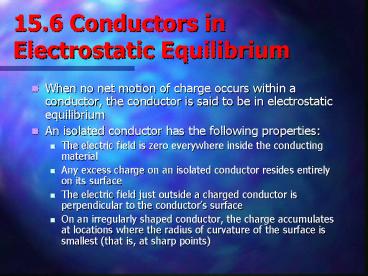15'6 Conductors in Electrostatic Equilibrium - PowerPoint PPT Presentation
1 / 18
Title:
15'6 Conductors in Electrostatic Equilibrium
Description:
Millikan Oil-Drop Experiment. Measured the elementary charge, e ... Millikan Oil-drop Experiment. 15.8 Van de Graaff. Generator ... – PowerPoint PPT presentation
Number of Views:262
Avg rating:3.0/5.0
Title: 15'6 Conductors in Electrostatic Equilibrium
1
15.6 Conductors in Electrostatic Equilibrium
- When no net motion of charge occurs within a
conductor, the conductor is said to be in
electrostatic equilibrium - An isolated conductor has the following
properties - The electric field is zero everywhere inside the
conducting material - Any excess charge on an isolated conductor
resides entirely on its surface - The electric field just outside a charged
conductor is perpendicular to the conductors
surface - On an irregularly shaped conductor, the charge
accumulates at locations where the radius of
curvature of the surface is smallest (that is, at
sharp points)
2
Property 1
- The electric field is zero everywhere inside the
conducting material (no potential drop) - Consider if this were not true
- if there were an electric field inside the
conductor, the free charge there would move and
there would be a flow of charge - If there were a movement of charge, the conductor
would not be in equilibrium
3
E0, no field!
- Note that the electric field lines are
perpendicular to the conductors and there are no
field lines inside the cylinder (E0!).
4
Property 2
- Any excess charge on an isolated conductor
resides entirely on its surface - A direct result of the 1/r2 repulsion between
like charges in Coulombs Law - If some excess of charge could be placed inside
the conductor, the repulsive forces would push
them as far apart as possible, causing them to
migrate to the surface
5
Property 3
- The electric field just outside a charged
conductor is perpendicular to the conductors
surface - Consider what would happen it this was not true
- The component along the surface would cause the
charge to move - It would not be in equilibrium
6
Property 4 (peak effect)
- On an irregularly shaped conductor, the charge
accumulates at locations where the radius of
curvature of the surface is smallest (that is, at
sharp points)
7
Property 4, cont.
- The charges move apart until an equilibrium is
achieved - The amount of charge per unit area is smaller at
the flat end
8
15.7 Experiments to Verify Properties of Charges
- Faradays Ice-Pail Experiment
- Concluded a charged object suspended inside a
metal container causes a rearrangement of charge
on the container in such a manner that the sign
of the charge on the inside surface of the
container is opposite the sign of the charge on
the suspended object - Millikan Oil-Drop Experiment
- Measured the elementary charge, e
- Found every charge had an integral multiples of e
- q n e
9
- Ice-pail experiment
- Negatively charged metal ball is lowered into a
uncharged hollow conductor - Inner wall of pail becomes positively charged
- Charge on the ball is neutralized by the positive
charges of the inner wall - Negatively charged hollow conductor remains
10
Millikan Oil-drop Experiment
11
15.8 Van de GraaffGenerator
- An electrostatic generator designed and built by
Robert J. Van de Graaff in 1929 - Charge is transferred to the dome by means of a
rotating belt - Eventually an electrostatic discharge takes place
12
15.9 Electric Flux and Gausss Law
- Field lines penetrating an area A perpendicular
to the field - The product of EA is the electric flux, F
- In general
- FE EA cos ?
13
- FEEAEA cos ?
q is the angle between the field lines and the
normal!
14
Convention Flux lines passing into the interior
of a volume are negative and those passing out of
the volume are positive
- A1A2L2
- FE1-EL2
- FE2EL2
- Fnet-EL2EL2 0
15
Gauss Law
- Ekeq/r 2
- FE EA
- A4?r 2
- FE 4?keq
- Nm2/CVm
Volt
16
Commonly, ke is replaced by the permittivity of
the free space
The electric flux through any closed surface is
equal to the net charge inside the surface
divided by ?0.
17
Electric Field of a Charged Thin Spherical Shell
- The calculation of the field outside the shell is
identical to that of a point charge - The electric field inside the shell is zero
18
Electric Field of a Nonconducting Plane Sheet of
Charge
Charge by unit area
?EE(2A)Q/?0?A/?0
- Use a cylindrical Gaussian surface
- The flux through the ends is EA, there is no
field through the curved part of the surface - The electric field is
- Note, the field is uniform































